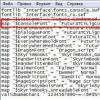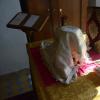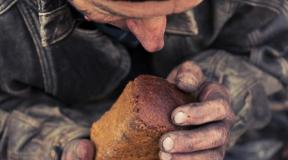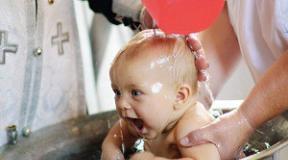Treating dog bites. Wounds after a dog bite: how to treat, treatment How to treat a dog after a bite
Dogs can get into a fight and bite each other for a variety of reasons.
Firstly, aggressive animals, asocial or poorly educated, provoke fights more often than others. Aggressiveness in a dog can be provoked by harsh treatment or improper upbringing, which can increase the dog's innate aggressiveness.
Secondly, as a rule, males start fights.
Thirdly, it can easily occur at the first meeting and acquaintance of two sexually mature dogs. If the dog is balanced, then the acquaintance is peaceful.
Fourth, dogs can compete with each other if they live in the same territory.
1. How to separate fighting dogs?
Agree, the first thing the owners are in a hurry to do is to quickly pull the dogs apart. But, this is not easy to do.
To separate dogs you need:
Letting the dogs off the leash
It is strictly forbidden to beat the dog.
It is undesirable to separate the dogs by the collars, because the outstretched hand is perceived by the dog as a threat and the owners can be bitten
If, nevertheless, it is necessary to separate the collar, it should be done by two owners at the same time. In this case, the collars should be twisted as tightly as possible.
If the dogs are grappling on dead, grab them by the collars and prepare a leash. You will have to twist the collars to cut off the oxygen and hold the dogs until they begin to choke and open their mouths. The first one to open the mouth is quickly put on a loop from the leash
If during a fight, both owners are next to each other, try to stretch the dogs by their hind legs and tail.
Alternatively, use sticks to open the jaws.
You can pour a bucket of water over the heads of the fighters or throw a jacket
In fact, there is no single recipe, and decisions have to be made in the thick of things. That is, already in battle.
Do not stretch dogs holding a grip on each other. Deep lacerations are guaranteed. If dogs are fighting with grapples, wait until they disengage and pull them to the sides.
Once you have managed to breed the fighters, ask the owner of the other dog for the exact address, phone number, and if the animal is vaccinated against rabies. In return, also provide all the information about your dog's health. Better if you show each other passports with vaccination marks.
Then hurry home and carefully examine your dog for damage, centimeter by centimeter.
2. Bite wounds in a dog: first aid
If the dog has been bitten by another dog, there will be holes in the skin. These are teeth marks. They cannot be called harmless. Fractures are rare, but it is best to gently feel where there are bites.
First aid:
For severe pain, inject an intramuscular analgesic baralgin
(for a dog weighing 30 kg or more - 1.5 ml) or analgin
with diphenhydramine
(1 ml: 1 ml)
dicinone
Use scissors to trim the hair around the wounds. Pre-treat scissors with an antiseptic
Treat all bite wounds 5% chlorhexidine
or miramistin
, and in deep wounds enter with a syringe
sulfacamphocaine
Note. Small wounds there is no need to tie. Moreover, don't stop your dog from licking them. The fact is that these bite marks can quickly heal, and an abscess forms inside. Therefore, sometimes the longer the wound does not heal, the better. Of course, these wounds are not sewn up.
No matter how you assess the severity of the injuries inflicted, urgently show the dog to the veterinarian. Only a specialist can correctly assess the condition of the wounds and prescribe an effective course of treatment.
As a last resort, call your doctor for advice on antibiotics and medication for bites.
3. Lacerated wounds in a dog: first aid
Torn wounds in a dog are loose flaps and torn skin. If the skin hangs down by 2 or more centimeters, then this is a 100% laceration.
Often the cause of such serious injuries is the misbehavior of the owners, who are struggling to pull the dogs away from each other.
If you are faced with such a disaster, your first task is to rush home and call a doctor. After all, lacerated wounds bleed a lot and are often accompanied by painful shock. In addition, such wounds often need to be sewn.
Moreover, the dog may tremble, not respond to external stimuli, have a pale shade of the mucous membrane of the mouth and a dropping temperature below 37 degrees.
The most dangerous are lacerations in the groin, abdomen, anus and head.
First aid:
Give your dog an immediate pain reliever. It could be baralgin
intramuscularly (for a dog weighing 30 kg or more - 1.5 ml) or analgin
with diphenhydramine
intramuscularly (1 ml: 1 ml)
You can give analgin tablets if you do not know how to give injections.
For severe bleeding intramuscularly dicinone
(for a dog weighing 30 kg and above the whole ampoule)
Dampen a napkin with a warm solution furacilina
and attach to the wound before the arrival of the veterinarian
If you notice that the dog has damaged blood vessels and muscles, wash the wound with solution furacilina
from the teapot, pour into the wound gelatin
and make a tight bandage. This will help to suspend the blood and hold out until the doctor arrives.
If the animal has increased salivation, shortness of breath, and it trembles, give an injection sulfacamphocaine
(for a dog 30 kg and more - a full intramuscular ampoule)
Most likely, after examination, the dog will be prescribed a course of antibiotics. If there are localized suppurative inflammations (abscesses), the doctor will clean the wounds, provide drainage, and teach you how to clean the wound.
And further.
Observe the condition of the dog for the first 6 hours after being bitten. Feel the bites every hour - head, paws, withers. So you can feel painful swellings and barely noticeable wounds on them. In this case, it may be necessary to open them, rinse them and put a drain.
A situation is also possible when, while feeling the bite sites, you will feel like rolling air bubbles or a kind of squelching under your fingers. This is a fibroma. And she requires immediate veterinary advice.
We wish your dog to meet only friendly and well-mannered fellow tribesmen on its way.
Be healthy!
Always yours, Dogs Balabaki.
P.P.S. Subscribe to our community at
The dogs that we affectionately call human friends can sometimes turn out to be our worst enemies. Dog bites can be very hazardous to health. Many people worry only about the fact that a scar will remain on the body for life, and do not even think about other dangers. A dog that has bitten a person can be sick and carry the rabies virus, which quickly penetrates the brain, destroying the nerve trunks and leading to death. In this case, the most dangerous are bites on the face, neck, head, hands. The disease will develop rapidly and will manifest itself by the tenth day after the bite. If the legs were bitten, then the manifestation of the disease is possible only after two to three months. After a dog bite, diseases such as staphylococcus, streptococcus, klebsiella, hemophilus, enterobacter, neisseria are possible.
To save a person, you need to know the basic methods of providing assistance after a dog bite. Be sure to rinse the bitten area on the body not just with water, but with some kind of solution with disinfecting properties. Rinsing should take at least five minutes. This will prevent the spread of the infection throughout the body. The infection, which can manifest itself, will make itself felt with purulent discharge, swelling of the bitten site, fever, redness of the skin. This should be the reason for visiting the doctor.
Signs of developing rabies can include hallucinations, fever, and severe, regular headaches. You might think that ordinary flu is developing - the symptoms of these diseases are so similar. Over time, there are convulsions, fear and aversion to water, gait disturbance, loss of strength. This, unfortunately, may indicate the presence of a rabies virus in the body.
This can be 3% hydrogen peroxide, as well as a solution of laundry soap. There is a special soap that has antibacterial properties. Then the wound needs to be treated with iodine, or better - brilliant green. If the wound is too deep, iodine can damage tissue and cause burns. You should also not use alcohol or handy tool- cologne. Such methods of providing care are important because a large number of bacteria, germs and microorganisms accumulate in the mouth of the animal. And if, nevertheless, the dog does not get sick with rabies, other life-threatening complications are possible. Further, after a dog bite, the wound must be covered with a special bactericidal plaster. As for the urgent stop of bleeding, if it is not strong, then nothing needs to be done, let some of the microbes be washed out of the wound along with the blood. If the bleeding is too strong, then a tourniquet or tight bandage is applied.
If a dog that has bitten can be screened for the rabies virus, it can be said for sure if it is sick. As a rule, dogs simply run away after being bitten. In this case, an injection against rabies will have to be given in any case. But today it is not such a terrible procedure that was used many years ago. Forty injections in the abdomen are no longer a topical therapy against rabies. The course of injections today is six injections, which are injected into the area of the trapezius muscle.
There are also folk methods helping people bitten by a dog. On the wound, you can apply various antiseptic dressings that are prepared at home. For example, turmeric disinfects the wound well, so it is mixed with honey and applied to the sore spot. It is also recommended to wash bites with water with the addition of manganese, which disinfects well. It is useful to treat the bite with echinacea tincture or plain water and salt. Often, after bites, walnut oil is used, it treats the wound from above so that the skin does not dry out, and it is also taken one spoonful by mouth three times during the day.
You can prepare an infusion of immortelle. For its preparation, only inflorescences are required. The infusion is drunk one spoonful three to four times a day. A mixture made from walnuts is useful. They are thoroughly chopped, mixed with salt and onions. A well-mixed mixture is applied to the wound. Asafoetida powder will help her heal faster. Sprinkling it over the area after a dog bite will reduce swelling and heal faster.
Nettle is considered an excellent disinfectant and healing folk remedy. It is sprinkled with regular salt and then applied to the bite site. This remedy relieves the bitten area well.
Lotions can be made from a mixture of garlic and honey. A gruel is prepared from these products, which is applied to the wound. You can use mashed onions instead of garlic. Garlic is recommended to be consumed in large doses and inside. Daily dose there must be at least four teeth. The gruel from the leaves of fresh meadowsweet also has a good healing effect. They are crushed and applied to the wound.
Vitamin C helps the wound heal quickly, so you need to include foods that contain it in your diet.
Contact medical institution it is necessary, even if a pet dog has bitten and vaccinated against all diseases. A person who is bitten by it may not be vaccinated against tetanus, and this is dangerous to health. Along with an injection against rabies, the victim is injected with anti-tetanus serum. In no case should you postpone a visit to the clinic, no matter what effective methods assistance you did not use. You should be especially careful with children bitten by dogs. Their body may be defenseless against the strongest viruses. This should be another signal to parents that they should not make their own decisions about refusing vaccinations for a child. Failure to vaccinate against tetanus can cost lives, even if the dog is not sick with rabies.
Unfortunately, if a person is bitten by a dog (both a stray and a domestic one), one should be afraid not only of massive bleeding or separation of a part of the organ, but also of infectious diseases. The situation is aggravated by the fact that some of the diseases that a dog transmits with a bite are practically incurable.
In this article, we will talk in detail about what exactly a dog bite can lead to and how first aid should be provided for it. We'll also tell you what to do to prevent infection from developing from the bite site.
A dog bite is divided into two types: lacerations and punctures. Each type of injury has its own consequences and degree of danger.
A laceration wound differs from a stab wound in the degree of damage. With her, there are the most serious injuries to the organ on which the bite fell. Crushing soft tissue from such a wound requires extensive cleaning.

In some cases, when cleaning a lacerated wound, it is necessary to remove part of the affected area (especially if the bite fell on the limbs). The reason is that sometimes it makes no sense to separate crushed tissues from healthy ones, since it will not be possible to clean everything perfectly. As a result, there is a risk of serious infection, so the issue is solved by removing the damaged tissue with the capture of several centimeters of healthy tissue.
A puncture wound (usually created by the canine of an animal) rarely requires tissue removal and, in general, the damage with it is minimal (if large vessels are not affected or the bite does not fall on abdominal cavity). But, despite this, this type of injury is more dangerous than the previous one.
The fact is that with a stab wound, a buffer is created between the external and internal environment. As a result, anaerobic conditions are created at the bottom of the wound (when oxygen cannot enter there), so favorable for several serious pathogenic bacteria species.
So, in the overwhelming majority of cases, tetanus, wound botulism and gas gangrene develop from puncture wounds. These are extremely dangerous diseases, the treatment of which very often does not give results. The problem is also that with deep wounds it is impossible to treat them, since the medicine does not always work to treat them entirely, to the full depth.
Possible consequences of a bite
In addition to the fact that the wound itself due to the bite can swell, there is a possibility of developing much more serious problems. One of them is painful shock, which in some cases can even lead to death (usually with a large area of the lesion, when there were multiple bites).
Serious blood loss is also possible, which can often be stopped only in a hospital setting. Bites in the inner femoral region are especially dangerous, since large arterial nodes lie there. It goes without saying that neck lesions are no less dangerous.

A child's bite, in addition to the above consequences, can lead to the development of persistent psychological trauma. In such cases, rehabilitation of the child can take years, and in some cases it may not be effective at all. A child can remain with fear of dogs all his life, which worsens his quality of life.
Dog bite (video)
What diseases can you get infected?
The main consequences of a dog bite, regardless of whether it is a home or a stray, are infectious diseases. Both domestic and yard dogs can tolerate and cause the following serious pathologies:
Statistically, only 20% of dogs are capable of open aggression (when it ends not only with barking, but also with bites). Usually these are courtyards (homeless, or those who are taken specifically to protect the territory) or fighting (breeds) dogs, protecting their territory from human encroachments.

If speak about development statistics various diseases after the bite, the numbers will be as follows:
Superficial bites, especially if bitten by someone other than a homeless woman domestic dog, in the overwhelming majority of cases, do not require contacting a doctor. An exception is cases of a bite in an area where rabies is often recorded.
Signs of serious injury due to which consult a doctor immediately and without fail, the following:
- if, after the injury, the leg or arm (or other place of the bite) is swollen;
- in cases where an arm or leg does not move well after a bite, in the case of a bite on the limbs (a sign of nerve damage or muscle clutches);
- if after a day the wound becomes black, festering;
- swollen The lymph nodes near the site of injury;
- consciousness is impaired, dizziness and / or problems with coordination of movements appear;
- with aches in bones and muscles;
- with nausea or vomiting;
- with spasms of the limbs;
- if there is bleeding that does not stop (even if the blood just oozes out);
- if the area around the bite looks pale, as if there is no blood flowing to the periphery of the wound.

With this symptomatology, you should contact the nearest trauma center (it works around the clock). If the symptoms are acute and intense, and there is no time or energy to go to the trauma center, you need to call an ambulance.
First aid for a bite: how to treat it?
As soon as after the bite the opportunity presents itself to deal with wound sanitation, it must be immediately disinfected. Perfectly first aid should look like this:
- If the bleeding is mild, you shouldn't let it stop right away. Let the blood leave the wound for a few minutes, so pathogenic microbes that could get into it from the saliva of the animal will be removed with the blood stream.
- Disinfect the wound as soon as possible. To do this, it is processed with antiseptic agents ( salicylic acid) and antibiotics (bactroban or analogs).
- On the periphery, the wound should be treated with iodine (iodidecyrin is best suited) and / or a solution of brilliant green.
- After the treatment is completed, you should drink a pain reliever (ketans, analgin).
- If the limbs are affected, it is best to fix them and give rest.
Vaccinations are required if the bite occurs in an area where rabies is common in animals, or if the animal that bitten looks suspicious. Also, in those people who have possible tetanus (lack of vaccination), compulsory vaccination in the conditions of a trauma center.

What's more, even people with an existing tetanus vaccine must be boosted. True, in this case, they will need only half of the normal dose.
First aid for a bite on the street
First aid for bites on the street carried out according to a slightly different tactics, since most often in street conditions there is simply no first-aid kit. Step by step, everything should look like this:
- The treatment of the wound surface from dirt and dog saliva is carried out using ordinary water or, in its absence, wet wipes. You can even wash the wound with sparkling water.
- Disinfect without pharmacy products the wound is impossible, therefore, you should consult a doctor. With bites outside the city, when doctors are not around, you can cauterize the surface of the wound, but this is a very risky method.
- To stop mild bleeding, it is enough to press a gauze or cloth bandage close to the wound and hold for about 10 minutes. A tourniquet can help with severe bleeding.
- After the bite and treatment, you should go home, where you need to once again rinse the wound surface and treat it with an antiseptic, after which you must consult a doctor.
Where to go if a dog bites?
Immediately after the bite, you need contact as soon as possible either to the emergency room of a hospital, or to a polyclinic, or to a trauma room (it works around the clock). In an emergency with extensive wounds and bleeding, you need to call an ambulance.
A traumatologist, infectious disease specialist and surgeon are involved in treating a patient in such situations. In some cases, with massive bleeding, it may be necessary to consult a vascular surgeon.
Should I see a doctor if bitten by a domestic dog?
Unfortunately, a bite from a domestic dog does not guarantee a favorable outcome. Obviously, a domestic dog is able to bite so hard that serious bleeding and damage to muscle fibers are possible.
But it's not only that. The problem is that even domestic dogs contain opportunistic microorganisms in their saliva. These are bacteria that, being in the oral cavity, do not cause problems, but when they get into the wound pocket (especially if there are anaerobic conditions there) they cause serious illness.
Therefore, it is imperative to consult a doctor even after being bitten by a domestic dog. It is especially important to do this in cases where the bite fell on the face or hands.
Further treatment
In a hospital setting, the wound will be treated much more thoroughly than in the case of self-treatment. Only doctors will be able to assess the need for a particular therapy and the severity of the wound.
In the hospital, it is possible to suture damaged vessels and nerves, restore the integrity of torn muscles and tendons. If necessary, a drip with antibiotics or treatment with oxygen saturation in a pressure chamber can be performed (if the possibility of developing gas gangrene or tetanus is suspected).
People with a questionable vaccination history will receive an emergency vaccination. The patient must be prepared for the fact that even with minor injuries he can be stopped overnight in the hospital to monitor his condition.
Prevention: how to avoid being bitten?
Not in all cases a bite can be avoided. However, there are a number of recommendations that significantly reduce this risk.

Gas gangrene is the worst complication of a dog bite
Namely:
- You should never provoke a street dog by looking into its eyes for a long time and waving your arms in front of it.
- Do not throw stones, bottles, or other things at dogs. Moreover, the dog may consider even a throw not at her, but next to her, as aggression, which must be remembered.
- Do not touch street puppies, as their mother is almost always there and immediately rushes to their protection.
- You cannot rip food out of dogs or pretend that you are going to do it (in other words, if the dog is eating, you cannot get too close to it or try to pet it).
- Jokes with dogs, in the form of imitation of barking or howling, can be misinterpreted by the dog and cause aggression in him, which must also be remembered.
3 numbers, one might say, was bitten by a dog (scratch through the pants). I washed it with triple cologne (I didn't know what to do with soap). In the evening, dried blood came out. On the 7th I turned to a traumatologist. The doctor recommended applying Levomekol and rinsing with hydrogen peroxide. A real wound has formed. Then there was a long-term treatment of the infected wound, which was very hot and itchy, it still itches. In early June, I turned to a dermatologist - after the doctor's prescriptions, the wound healed, there was a small dot, which coalesces, but does not heal. About the dog - I saw it alive and normal for more than 80 days after the bite, then disappeared somewhere. Now I am sick (possibly related to the bite?) colds- cough, low temperature, pain in the trachea.
Answer
A dog bite is a frequent and dangerous injury that provokes a number of serious complications, including a list of infectious diseases, and reaches the point of rabies. Often the bite is provoked by human behavior, for example, when attempts are made to take away fighting dogs. Men are more likely to be bitten than women.
If an injury is received, severe pain appears, and acute inflammation develops. Sometimes there is suppuration of the bite site. Pus has an unpleasant, pungent odor. It is possible for the infection to spread to bone tissue and joints, causing osteomyelitis.
Treatment of a dog bite is a complex and multi-stage process that requires an integrated approach and observation by a surgeon, infectious disease specialist and dermatologist. Often, dog bites are a lacerated wound, a little less often - a puncture wound.
As a rule, an attacking dog never looks a person in the eye. Do not try to interfere when the dog is eating, fighting, or mating. Do not allow the animal to lick open wounds.
How do dog bites manifest?
If the bitten wound is not treated in time, and an infection has joined, the patient's body temperature may rise, regional lymph nodes increase. The causative agent of the infectious process is often staphylococcus or green streptococcus. Injuries are contaminated with a large number of bacterial bodies. It is dangerous, a number of infectious diseases are likely - meningitis, abscesses, endocarditis, sepsis. Individuals with a reduced immune response of the body have a much higher risk of getting an infectious complication than healthy people.
A dog bite can lead to the development of specific infections: tetanus or rabies. When a certain pathogen enters the wound area, a disease begins, which is expressed by disorders in the functioning of the kidneys and liver, a decrease in immunity. To determine the pathogen, it is necessary to make a smear from the wound according to Wright.
First aid for a bite
- If a person, for some reason, has been attacked by an aggressive animal, it is necessary to treat the damage as soon as possible. Urgent measures are taken within the first days after injury.
- Of great importance is the fact which dog has bitten - domestic, neighbor, stray, unknown.
- When seeking medical help, the traumatologist finds out where the injury is located, what is the degree and depth of damage to the tissue, nearby vessels and nerve trunks. The severity of the bite and the size of the wound are important.
- When attacking the face, the aesthetic side of the issue is taken into account. If an eye, nerve trunk, or muscle is affected, one speaks of a functional lesion.
- Superficial bites are not particularly dangerous. It is recommended to thoroughly wash the skin with laundry soap under running water. Deep wounds are considered dangerous. It becomes necessary to stop bleeding with a tourniquet or pressure bandage. With severe pain syndrome, it is shown to take an anesthetic.
- The wound can be washed with a manganese solution or echinacea tincture, aqueous solution chlorhexidine. The skin around the bite site is treated with an alcoholic tincture of iodine. It is important to thoroughly rinse the wound to completely clear the lesion of canine saliva, which often contains pathogens and viruses.
Further assistance
If the affected area is very bleeding, has a large size, the help of a surgeon or traumatologist is needed. With severe pain syndrome, the administration of analgesics, antihistamines is indicated. In case of fright, it is permissible to take a sedative.
In case of deep trauma, the surgeon performs the processing of the edges, sutures. In parallel, antibiotic treatment is prescribed to prevent infection. Emergency prevention of tetanus and rabies is being carried out.
If the size of the damage is small, a sterile gauze bandage with an antiseptic or antibacterial and wound-healing ointment is applied. A lacerated wound heals more slowly than a puncture wound and is accompanied by the formation of a rough stellate scar. If the skin is treated and the edges are excised, healing occurs quickly and favorably.
If the wound does not heal for a long time
Healing after canine teeth is a long and complex process. It requires local and systemic treatment.
- If the skin does not tighten for a long time, discharge is noted, a diagnostic smear will be required to determine the presence of pathogenic flora and sensitivity to antibiotics. Based on the results of the analysis, antibacterial drugs... You can take antibiotics in tablets, do intramuscular injections.
- To relieve inflammation and itching, non-steroidal anti-inflammatory and antihistamines are prescribed in injections or tablets.
- It is useful to carry out a course of treatment with immunomodulators, vitamins.
- It is allowed to use in complex treatment folk remedies... A mixture of honey and turmeric is applied to the wound. The composition has a disinfecting and biostimulating effect.
- It is possible to apply a home remedy made from onions, salt and walnut kernels to the bite area.
If the bite area does not heal for a long time, there are signs of complication, the doctor will offer hospitalization for the purpose of examination and determination of further treatment tactics.
In the recovery period, physiotherapeutic treatment is prescribed, aimed at accelerating tissue regeneration and removing signs of inflammation.
After a dog's bite, the hand is swollen, what should be done in this situation and how to treat the bite - a dog's attack is a situation from which no one is immune. If the limb is swollen after the attack, it hurts, this may be a sign of infection. Everyone should know what measures emergency it is necessary to take to protect yourself and loved ones from serious consequences, many of which can be fatal.
The severity of the clinical case depends on many factors, in particular the size of the animal and the degree of its aggressiveness. The most serious injuries are those caused by fighting breeds - shepherds, pit bulls, bull terriers. Types of bites:
- stabbed (superficial) - violation of the integrity of the skin, tissue rupture, extensive swelling. Such an injury is considered the easiest, with the provision of first aid to the victim, and the absence of complications, healing takes place quickly;

- torn - ruptures of soft tissues, joints, damage to blood vessels. With such an injury, there are high risks of complications; the victim must be taken to a medical facility as soon as possible.

The most common adult bite sites are the hands, forearms, and ankles. Children have a head, face and neck. Neck injuries are the most dangerous, since the carotid artery passes there and its damage leads to profuse blood loss with a fatal outcome.
The health status of the animal has an impact on the consequences of a bite. After being bitten by a dog, if it has been infected with infections, or if it contains pathogenic bacteria in its saliva, there is a high risk of human infection.

If, after an attack, a damaged part of the body swells in a person, this is a sign that should be consulted immediately with a doctor. Even if one finger is swollen, into the tissue of which pathogenic microorganisms have entered, this can lead to the fact that the infection spreads throughout the body, and then the likelihood of death increases significantly.
Effects
Less dangerous are bites that hit areas of the body covered by clothing, without deep damage to soft tissues and blood vessels. Swelling in such cases is rare. Dangerous are the consequences after a stab bite of a dog, when damaged blood vessels, bleeding opens, a tumor forms. If there is an open wound, the likelihood of infection is very high, and in addition to providing primary care, complex treatment is required.

Infection of a person is indicated by symptoms such as persistent bleeding, enlarged lymph nodes, signs of general poisoning and attacks of a neurological disorder, edema. The patient develops nausea and vomiting, and the body temperature rises. Symptoms such as swelling of soft tissues, the appearance of a rash on the skin, and a fever in the affected person are especially dangerous. If the bite site swells, this indicates infection with pathogenic bacteria.
If there is a suspicion that an infection has gotten you urgently need to seek medical help. Many diseases transmitted by saliva that gets into an open wound are deadly.
Rabies
People who have been injured often have rabies. This is the hardest infection... The bacteria are found in the saliva of an infected animal, and if saliva gets on an open wound, the chances of a person becoming infected are close to 100%. Without the provision of urgent medical care, a person dies when infected.

The intensity of the symptoms of the disease increases gradually. The first sign of the disease is painful swelling of the tissues. 1-2 weeks after infection, symptoms such as fever, swelling of soft tissues, severe headaches, general weakness, the swelling increases. There are signs of poisoning, an attack of central nervous system, joint aches after a bite, and severe stress aggravates the condition. When infected with rabies, a person becomes aggressive, nervous and overly irritable, his appetite disappears, and insomnia appears. The swelling on the skin becomes hot and painful.

Treatment for a dog bite is the administration of a special rabies vaccine. Additionally, complex symptomatic therapy is carried out to restore impaired body functions.
Tetanus
Tetanus infection can occur after a dog bites. The disease is just as dangerous as rabies. Symptoms of the development of tetanus develops gradually, the duration incubation period from 1 week to a month.

Infection with Escherichia coli through the saliva of an infected animal is accompanied by swelling of the skin at the site of the bite, pulling pain appears, and muscle cramps occur. If health care will not be rendered on early stages, the intensity of the signs increases.

First, the skin swells, reddens. The swelling becomes painful. Spasms of facial and chewing muscles appear. A person cannot swallow food, the convulsions intensify. Possible consequences tetanus: rupture of muscle fibers, fractures of the spinal column, cardiac arrest.
How to treat a dog bite
Emergency bite treatment consists of proper wound care and swelling control. It must be washed with an antiseptic, for example, hydrogen peroxide, iodine, Betadine, Chlorhexidine. You can also treat a wound or a swollen place with a solution of brilliant green. Moderate bleeding does not need to be stopped, pathogenic bacteria that have entered the wound will flow out with the blood. After the attack of the dog, what to do if the bleeding is profuse - it is necessary to put a tourniquet on the injured limb and fix it in an elevated position. After the wound has been cleaned, a sterile dressing is applied.

If the injury is accompanied by a swelling, how to remove the swelling after a bite? For this, a cold compress is applied. It is forbidden to bandage tightly, put cotton wool or bandage into the wound. Immediately after the bite, if a stray animal has attacked, and there is a possibility that it is infected with rabies, or tetanus, it is necessary to treat the wound with a solution of water and laundry soap. After providing primary care, you should immediately contact the emergency room. Treatment after a dog bite is complex.
In the hospital, a medical treatment of the wound is carried out, the swelling on the skin is stopped. To determine the depth of the injury, you need to do an ultrasound, the victim takes blood and a smear from the site of the bite for laboratory tests. If the dog has bitten but the wound is not deep and the swelling is insignificant, the patient can be treated at home, which includes drug therapy and alternative methods. How to treat a wound at home - lotions from a decoction of herbs and plants are used, which have a calming and antiseptic effect, relieve swelling - chamomile, St. John's wort, oak bark.

How to treat a patient with rabies infection - an anti-rabies vaccine is administered. A total of 6 injections are given to the shoulder. When infected with E. coli, treatment is carried out with a tetanus vaccine. Immediately after the nurse has given an injection for rabies, or tetanus, immunoglobulin vaccine is given.
If there is no infection, the symptoms are not expressed, the limb swelling is small, antibiotics are prescribed - Augmentin, Ceftriaxone, Amoxiclav, Lincomycin. Antibiotics are selected individually, depending on the type of pathogenic microflora. Duration antibacterial therapy- Week 1.
After a dog bite, swelling of soft tissues or the development of severe, often fatal consequences can be prevented only by immediately contacting a medical institution. If possible, it is necessary to establish observation of the attacking animal in order to understand from its behavior whether the dog is infected with rabies. Rabies vaccine is not given in cases when a domestic dog has attacked, and the owner has vaccination cards for the animal that indicate a recent vaccination.



















